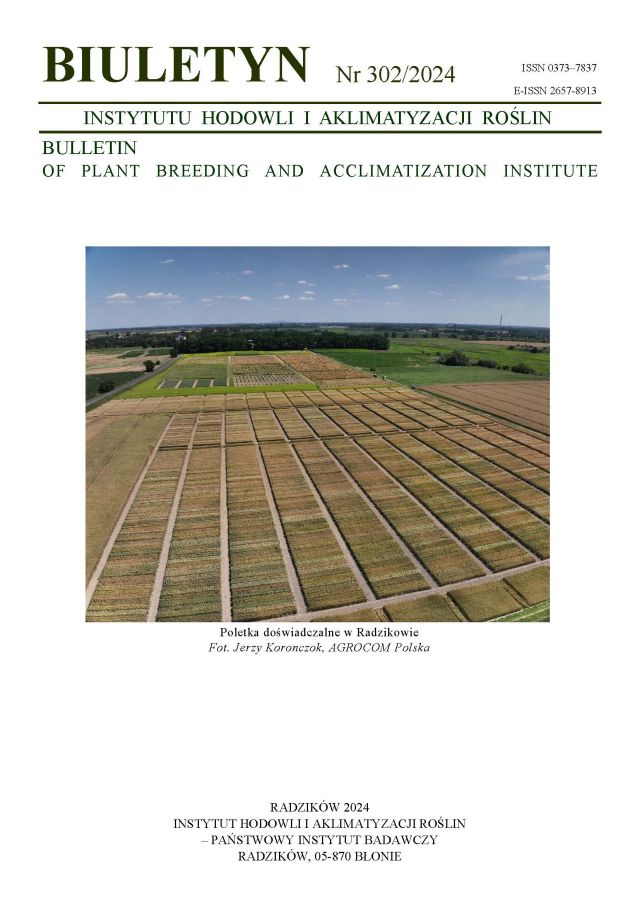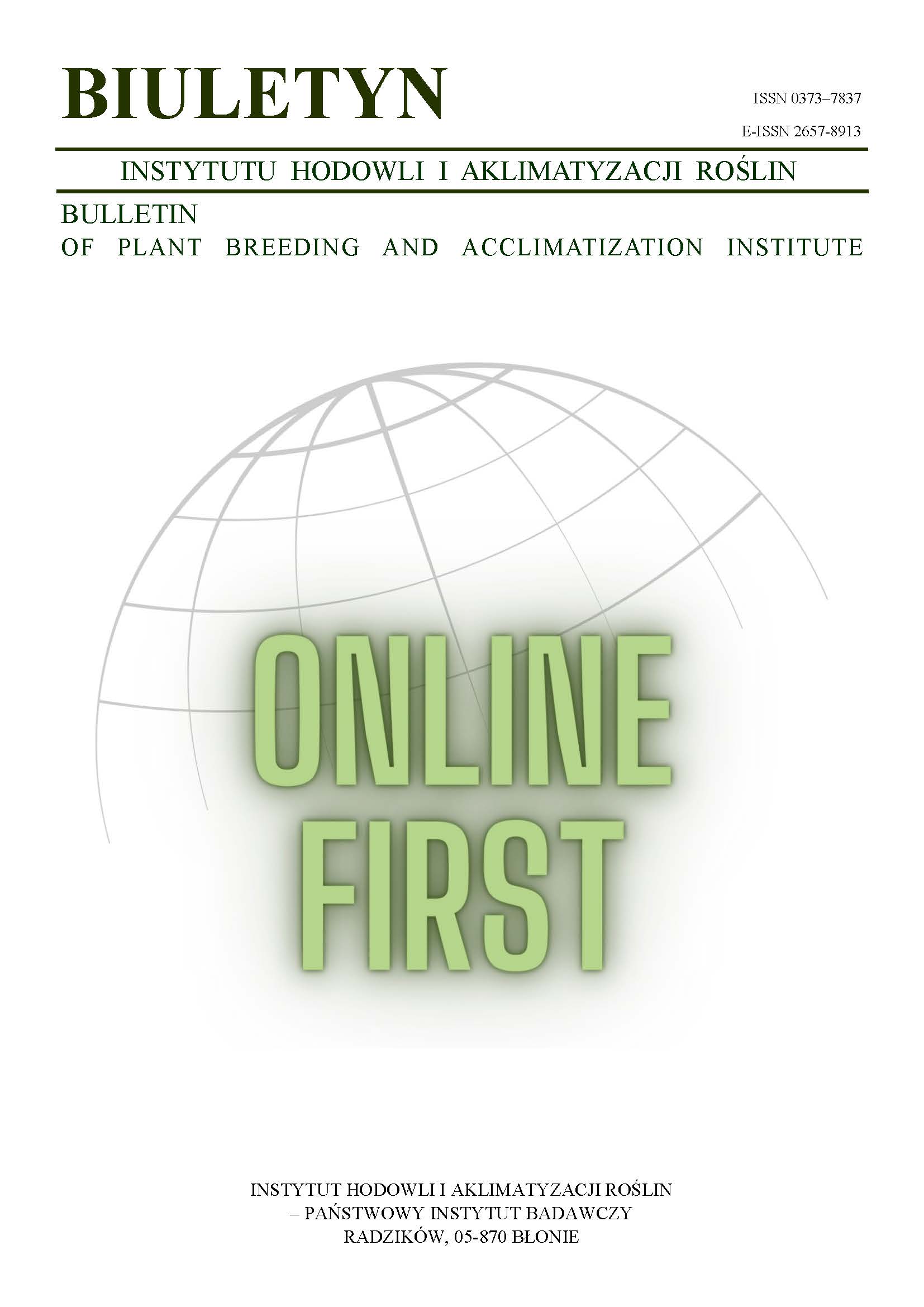Comparison of some properties of native and partially defatted starch of oat cultivar Akt
Wiktor Berski
ktw@urk.edu.plKatedra Technologii Węglowodanów, Akademia Rolnicza w Krakowie (Poland)
Anna Ptaszek
Katedra Inżynierii i Aparatury Przemysłu Spożywczego, Akademia Rolnicza w Krakowie (Poland)
Paweł Ptaszek
Katedra Inżynierii i Aparatury Przemysłu Spożywczego, Akademia Rolnicza w Krakowie (Poland)
Bohdan Achremowicz
Katedra Technologii Węglowodanów, Akademia Rolnicza w Krakowie (Poland)
Abstract
Oat starch, compared to the starches of other plants, is characterized by a high content of lipids, which strongly determines its properties. The aim of this work was to evaluate the properties of starch isolated from Polish naked oat cultivar Akt. In order to assess a role of lipids in determining starch properties, the starch was subjected to the fat removal process. Special conditions were set to minimalize harmful effects of the process upon a grain structure. Both, the native oat starch and the defatted starch were analyzed for their amylose, lipids and phosphorus content. Moreover, water binding capacity (WBC) and solubility as well as pasting ability and granules size distribution were characterized. In addition, oscillatory and hysteresis loop tests were carried out, and gelatinization parameters were determined using a differential scanning calorimetry (DSC) method. The removal of fat effected in the increase in granules size and apparent amylose content as well as in the decrease in lipids and phosphorus content. Also, the increase both in WBC and solubility, and the decrease in gelation enthalpy and broadening of enthalpy peak were observed. Moreover, the decrease in gelatinization temperature and viscosity parameters was recorded. Starch gel prepared from the defatted starch was characterized by lower values of loss and storage modules, but shapes of curves were similar to those obtained with gel prepared using the native starch. These changes indicate the partial destruction of starch granules structure in the process of fat removal.
Supporting Agencies
Keywords:
defatting, oat starch, physico-chemical propertiesReferences
Buleon A., Colonna P., Planchot V., Ball S. 1998. Starch granules: structure and biosynthesis. Intern. J. Biol. Macromolecul. 23: 85 — 112.
DOI: https://doi.org/10.1016/S0141-8130(98)00040-3
Google Scholar
Forsell P., Hamunen A., Autio K., Suorti T., Poutanen K. 1995. Hypochlorite oxidation of barley and potato starch. Starch/Stärke 47: 371 — 377.
DOI: https://doi.org/10.1002/star.19950471002
Google Scholar
Fortuna T., Juszczak L. 2000. Wybrane właściwości skrobi różnego pochodzenia. Zeszyty Naukowe AR w Krakowie, 367: 39 — 50.
Google Scholar
Fortuna T., Juszczak L., Pałasiński M. 1999. Physico-chemical properties of defatted starches. Pol. J. Food Nutr. Sci., 49: 177 — 184.
Google Scholar
Fortuna T., Pałasiński M. 1994. Właściwości fosforanów dwuskrobiowych otrzymanych z odtłuszczonych skrobi zbożowych. Zeszyty Naukowe AR w Krakowie, 6: 67 — 75.
Google Scholar
Gambuś H., Gutterch R., Nowotna A., Praznik W. 1996. Physico-chemical properties of defatted triticale starch. Żywność. Technologia. Jakość. 2: 158 — 164.
Google Scholar
Gambuś H., Nowotna A. 1992. Physicochemical properties of defatted triticale starch. Pol. J. Food Nutr. Sci. 42: 101 — 107.
Google Scholar
Gibiński M. 1992. Funkcjonalne właściwości skrobi owsianej. Porównanie różnych metod wyosabniania skrobi. Zeszyty Naukowe AR w Krakowie 274: 33 — 43.
Google Scholar
Gibiński M. Pałasiński M., Tomasik P. 1993. Physicochemical properties of defatted oat starch. Starch/Stärke, 45: 354 — 357.
DOI: https://doi.org/10.1002/star.19930451006
Google Scholar
Gudmundsson M., Eliasson A. C. 1989. Some physico-chemical properties of oat starches extracted from varieties with different oil content. Acta Agric Scand. 39: 101 — 111.
DOI: https://doi.org/10.1080/00015128909438502
Google Scholar
Harrison G., Franks G. V., Tirtaatmadja V., Boger D. V. 1998. Suspensions and polymers — Common links in rheology. Korea-Australia Rheology Journal 11: 197 — 218.
Google Scholar
Hartunian-Sowa M., White P. J. 1992. Characterization of starch isolated from oat grain with different amount of lipid. Cereal Chemistry, 69: 521 — 527.
Google Scholar
Hoover R., Senanayake S. P. J. N. 1996. Composition and physicochemical properties of oat starches. Food Research International 29 (1): 15 — 25.
DOI: https://doi.org/10.1016/0963-9969(95)00060-7
Google Scholar
Hoover R., Smith C., Zhou Y., Ratnayake R. M. W. S. 2003. Physicochemical properties of Canadian oat starches. Carbohydrate Polymers 52: 253 — 261.
DOI: https://doi.org/10.1016/S0144-8617(02)00271-0
Google Scholar
Kavanagh G. M., Ross-Murphy S. B. 1998. Rheological characterization of polymer gel. Prog. Polnym. Sci. 23: 533 — 562.
DOI: https://doi.org/10.1016/S0079-6700(97)00047-6
Google Scholar
Łomnicki A. 2003. Wprowadzenie do statystyki dla przyrodników. PWN, Warszawa.
Google Scholar
Marsh B. B. 1959. The estimation of inorganic phosphate in the presence of adenosine triphosphate. Biochem. Biophys. Acta 32: 357.
DOI: https://doi.org/10.1016/0006-3002(59)90607-9
Google Scholar
Morrison W. R 1988. Lipids in cereal starches: a review. J. Cereal Sci. 8: 1 — 15.
DOI: https://doi.org/10.1016/S0733-5210(88)80044-4
Google Scholar
Morrison W. R., Laignelet B. 1983. An improved calorimetric procedure for determining apparent and total amylose in cereal and other starches. J. Cereal Sci. 1: 9 — 20.
DOI: https://doi.org/10.1016/S0733-5210(83)80004-6
Google Scholar
Morrison W. R., Law R. V., Snape C. E. 1993. Evidence for inclusion complexes of lipids with V-amylose in maize, rice and oat starches, J. Cereal Sci. 18: 107 — 109.
DOI: https://doi.org/10.1006/jcrs.1993.1039
Google Scholar
Mua J. P. Jackson D. S. 1995. Gelatinization and solubility properties of commercial oat starches. Starch/Stärke 47: 2 — 7.
DOI: https://doi.org/10.1002/star.19950470103
Google Scholar
Nowotny F. (red.). 1969. Skrobia. WNT, Warszawa.
Google Scholar
Pałasiński 1994 Właściwości skrobi różnego pochodzenia. Postępy Nauk Rolniczych 3: 47 — 59.
Google Scholar
Pałasiński M., Gibiński M. 1991. Untersuchungen über die Stärke aus polnischen Hafersorten. Wissenschaftliche Zeitschrift der TH Köthen, 2 (4): 45 — 52.
Google Scholar
Paton D. 1977. Oat starch I. Extraction, purification and pasting properties. Starch/Stärke 29: 149 — 153.
DOI: https://doi.org/10.1002/star.19770290502
Google Scholar
Richter M., Augustat S., Schierbaum F. 1969. Ausgewahlte Metoden der Stärkchemie. VEB, Fachbuchverlag, Leipzig.
Google Scholar
Shamekh S., Forssell P., Poutanem K. 1994. Solubility pattern and recrystalization behaviour of oat starch. Starch/Stärke, 46: 129 — 133.
DOI: https://doi.org/10.1002/star.19940460403
Google Scholar
Steffe J. M. 1996. Rheological methods in food process engineering. Freeman Press, Lansing MI, USA.
Google Scholar
Tester R. F., Karkalas J. 1996. Swelling and gelatinization of oat starches. Cereal Chemistry 73: 271 — 277.
Google Scholar
Tester R. F., Karkalas J., Qi X. 2004. Starch — composition, fine structure and architecture. J. Cereal Sci. 39: 151 — 16.
DOI: https://doi.org/10.1016/j.jcs.2003.12.001
Google Scholar
Tomasik P. Gładkowski J. 2001. Polisacharydy a ekonomia XXI wieku. Żywność. Nauka. Technologia. Jakość. 2: 17 — 27.
Google Scholar
Wang L. Z., White P. J. 1994. Functional properties of oat starches and relationships among functional and structural characteristics. Cereal Chemistry 71: 451 — 458.
Google Scholar
Yoo S. H., Jane J. 2002. Structural and physical characteristics of waxy and other wheat starches. Corbohydr. Polym. 49: 297 — 305.
DOI: https://doi.org/10.1016/S0144-8617(01)00338-1
Google Scholar
Zhou M., Robards K., Glennie-Holmes M., Helliwell S. 1998. Structure and pasting properties of oat starch. Cereal Chem. 75: 273 — 281.
DOI: https://doi.org/10.1094/CCHEM.1998.75.3.273
Google Scholar
Zobel H. F. 1988. Molecules to granules: a comprehensive starch review. Starch/Stärke 40 (2): 44 — 50.
DOI: https://doi.org/10.1002/star.19880400203
Google Scholar
Authors
Wiktor Berskiktw@urk.edu.pl
Katedra Technologii Węglowodanów, Akademia Rolnicza w Krakowie Poland
Authors
Anna PtaszekKatedra Inżynierii i Aparatury Przemysłu Spożywczego, Akademia Rolnicza w Krakowie Poland
Authors
Paweł PtaszekKatedra Inżynierii i Aparatury Przemysłu Spożywczego, Akademia Rolnicza w Krakowie Poland
Authors
Bohdan AchremowiczKatedra Technologii Węglowodanów, Akademia Rolnicza w Krakowie Poland
Statistics
Abstract views: 23PDF downloads: 11
License
Copyright (c) 2006 Wiktor Berski, Anna Ptaszek, Paweł Ptaszek, Bohdan Achremowicz

This work is licensed under a Creative Commons Attribution-ShareAlike 4.0 International License.
Upon submitting the article, the Authors grant the Publisher a non-exclusive and free license to use the article for an indefinite period of time throughout the world in the following fields of use:
- Production and reproduction of copies of the article using a specific technique, including printing and digital technology.
- Placing on the market, lending or renting the original or copies of the article.
- Public performance, exhibition, display, reproduction, broadcasting and re-broadcasting, as well as making the article publicly available in such a way that everyone can access it at a place and time of their choice.
- Including the article in a collective work.
- Uploading an article in electronic form to electronic platforms or otherwise introducing an article in electronic form to the Internet or other network.
- Dissemination of the article in electronic form on the Internet or other network, in collective work as well as independently.
- Making the article available in an electronic version in such a way that everyone can access it at a place and time of their choice, in particular via the Internet.
Authors by sending a request for publication:
- They consent to the publication of the article in the journal,
- They agree to give the publication a DOI (Digital Object Identifier),
- They undertake to comply with the publishing house's code of ethics in accordance with the guidelines of the Committee on Publication Ethics (COPE), (http://ihar.edu.pl/biblioteka_i_wydawnictwa.php),
- They consent to the articles being made available in electronic form under the CC BY-SA 4.0 license, in open access,
- They agree to send article metadata to commercial and non-commercial journal indexing databases.
Most read articles by the same author(s)
- Marek Gibiński, Wiktor Berski, Properties of starch from selected Polish cultivars of oat , Bulletin of Plant Breeding and Acclimatization Institute: No. 239 (2006): Regular issue














